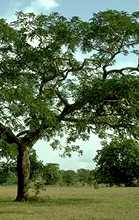View crop
View crop Data sheet EcoPortParkia biglobosa
 |
|
| Notes |
|---|
| DESCRIPTION: It is a deciduous tree reaching 7-20 m in height, although it can reach 30 m. Crown large, spreads wide with branches low down on a stout bole, bark dark grey brown, thick, fissured. Leaves alternate, dark green, bipinnate to 30 cm long. Pods, pink brown to dark brown when mature, about 45 cm long and 2 cm wide. USE: Seed, pods and leaves are edible and pods also used as fodder. Flowers produce nectar. Wood is used for small implements and as fuel. Gum and tannin can be extracted from the pods. Bark and pods are poisonous to fish. Bark is used as a mouthwash, vapour inhalant for toothache, or for ear complaints. It is macerated in baths for leprosy and used for bronchitis, pneumonia, skin infections, sores, ulcers, bilharzia, washes for fever, malaria, diarrhoea, violent colic and vomiting, sterility, venereal diseases, guinea worm, oedema and rickets, and as a poison antidote. Leaves are used in lotions for sore eyes, burns, haemorrhoids and toothache. Seed is taken for tension, and pulp for fevers, as a diuretic and as a mild purgative. Roots are used in a lotion for sore eyes. The tree is a useful windbreak, shade tree and used in agroforestry. GROWING PERIOD: Perennial. First fruiting after about 8 years and full bearing after 15-20 years. COMMON NAMES: African locust bean. FURTHER INF: It can be found at elevations between sea level and 300 m. Range of natural occurrence is 5-15°N. It occurs on a wide range of natural and semi-natural communities such as open savannah woodlands, but it is most conspicuous and abundant in anthropic communities, principally bush fallow and wooded farmland where cultivation is semi-permanent. The tree can also grow on rocky sl | Sources |
| Grassland Index Weeb D 1984 pp 200 [RAIN, TEMP, PH, USE] INSPIRE species 117 [RAIN, TEMP, PH, USE] Maydell H 1986 pp 339-341 [DEP, TEXT, RAIN, USE] ICRAF Agroforestree Database |